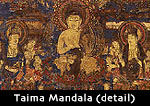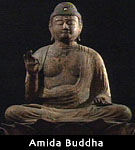 |
Video: Japanese Buddhism - Transcript
 Buddhism is based on the teachings of an Indian prince who lived about 500 years before Christ. It spread throughout India...eastward into Southeast Asia...and northward into China. In its wake were produced some of the greatest monuments of religious art the world has ever known. Buddhism is based on the teachings of an Indian prince who lived about 500 years before Christ. It spread throughout India...eastward into Southeast Asia...and northward into China. In its wake were produced some of the greatest monuments of religious art the world has ever known.
 Buddhism was formally introduced to Japan nearly 1500 years ago by diplomatic envoys from the nearby Korean peninsula. Based on the premise that life is suffering, and that suffering is caused by earthly desires, Buddhism offered a means to achieve enlightenment, or nirvana. Nirvana is the cessation of human cravings, which bind people to an endless cycle of birth and death. Buddhism was formally introduced to Japan nearly 1500 years ago by diplomatic envoys from the nearby Korean peninsula. Based on the premise that life is suffering, and that suffering is caused by earthly desires, Buddhism offered a means to achieve enlightenment, or nirvana. Nirvana is the cessation of human cravings, which bind people to an endless cycle of birth and death.
Of the many factions of Buddhism which came to flourish in Japan, the one that brought comfort and inspiration to the broadest cross-section of humanity was the worship of Amida, the Buddha of Infinite Light. Amida Buddha was only one of many Buddhist deities imported from the Asian continent in the sixth century. In Japan, worship of Amida grew progressively popular, reaching a golden age between the 10th and 13th centuries. Even today, followers of this gentle and compassionate deity make up the greatest number of Buddhists in Japan.
 According to ancient Buddhist scriptures, in eons past Amida vowed to create a paradise where people could strive toward enlightenment without the pain and suffering associated with life on Earth. According to ancient Buddhist scriptures, in eons past Amida vowed to create a paradise where people could strive toward enlightenment without the pain and suffering associated with life on Earth.
This image of Amida's paradise from the museum's collection was painted in Japan early in the 14th century. It is a mandala, or diagram of a portion of the Buddhist cosmos—in this case the Pure Land or Western Paradise of Amida. The original mandala, imported from China, was kept at the Taima temple. Because of this, such mandalas are often referred to as Taima mandalas. Amida is shown beneath a jeweled canopy, seated on a lotus throne. Like all celestial beings, he is rendered in gold to suggest the light, which emanates from his body. Surrounded by a heavenly host of bodhisattvas and musicians, Amida presides over the palaces and gardens of his Western Paradise. In the foreground, the souls of the faithful are shown being reborn on lotus blossoms, which rise from the reflection pond.
Paintings such as these were intended to help believers visualize Amida's paradise. By earnestly concentrating on Amida and his heavenly surroundings, constantly invoking his name, followers could help ensure their rebirth in the Pure Land. There they would be free of all pain and suffering. Their eyes would be dazzled by trees of jewels. Various birds and musicians would create delightful music. The air would be fragrant, and the water in the rivers would run warm or cool according to each person's desires. In such a place without pain or want, the faithful could devote themselves fully to achieving enlightenment.
 During the 11th century in Japan, when belief in Amida reached a high point, Japanese noblemen actually tried to recreate Amida's paradise on Earth. Built in 1053 by Fujiwara Yorimichi, a high-ranking nobleman, the Hoodo or Phoenix Hall of the Byodo-in temple closely resembles the Institute's painting of the Pure Land. During the 11th century in Japan, when belief in Amida reached a high point, Japanese noblemen actually tried to recreate Amida's paradise on Earth. Built in 1053 by Fujiwara Yorimichi, a high-ranking nobleman, the Hoodo or Phoenix Hall of the Byodo-in temple closely resembles the Institute's painting of the Pure Land.
Seated within the elegant, palace-like pavilion, an image of Amida shimmers with a layer of gold. Created by artist Jocho in the 12th century, every detail serves to suggest Amida's radiant calm and quiet serenity as he presides over a beautiful pond surrounded by flowering plants and trees.
 Based on the precedent set by Jocho in the 12th century, later sculptors created similar images of Amida. The Amida in the collection of the Institute of Arts, originally covered with gold, still conveys the over-riding benevolence of this deity. The face is full and untroubled, with dreamy, nearly closed eyes suggesting Amida's serene, introspective nature. This effect is heightened by the shallowly carved folds of the robe falling softly across the shoulder and over the lap. Amida's hands are held in one of many symbolic gestures, known as Mudra. His right hand dispels fears, while his left is held in a gesture of charity. The overall effect is one of reassuring calm and quietude, and undoubtedly provided worshippers with a sense of great comfort. Based on the precedent set by Jocho in the 12th century, later sculptors created similar images of Amida. The Amida in the collection of the Institute of Arts, originally covered with gold, still conveys the over-riding benevolence of this deity. The face is full and untroubled, with dreamy, nearly closed eyes suggesting Amida's serene, introspective nature. This effect is heightened by the shallowly carved folds of the robe falling softly across the shoulder and over the lap. Amida's hands are held in one of many symbolic gestures, known as Mudra. His right hand dispels fears, while his left is held in a gesture of charity. The overall effect is one of reassuring calm and quietude, and undoubtedly provided worshippers with a sense of great comfort.
 Another aspect of Amida's boundless compassion is known as raigo, or the "welcoming descent of Amida." This type of imagery stems from Amida's vow to personally appear at the moment of death, in order to insure safe passage and rebirth of the soul in the Pure Land. Another aspect of Amida's boundless compassion is known as raigo, or the "welcoming descent of Amida." This type of imagery stems from Amida's vow to personally appear at the moment of death, in order to insure safe passage and rebirth of the soul in the Pure Land.
In this painting from the permanent collection, Amida is shown floating downward from the clouds. He is accompanied by his attendant bodhisattvas: Seishi, whose hands are clasped in prayer, and Kannon, who bears a lotus upon which to receive the soul of the dying. Rays of light radiate outward from Amida, whose body has been rendered in gold to emphasize his divinity. His robes, finely painted in thin, even lines, are delicately patterned with cut gold foil, known in Japanese as kirikane. The effect is one of great luxury and ease, foreshadowing the splendors of Western Paradise. Such a painting, hung by the bed, would have provided a focus for the dying person, bringing considerable comfort and hope in their final hours.
 So compelling was the concept of Amida coming to welcome a soul at the moment of death, that several other deities also came to be depicted descending from the heavens. The swirling clouds beneath this figure indicate that it is also a raigo,a heavenly descent. A masterpiece of Japanese Buddhist sculpture from the 13th century, here at the Minneapolis Institute of Arts, represents the Bodhisattva Jizo. Jizo was believed to come to the aid of people condemned to the torments of hell. So compelling was the concept of Amida coming to welcome a soul at the moment of death, that several other deities also came to be depicted descending from the heavens. The swirling clouds beneath this figure indicate that it is also a raigo,a heavenly descent. A masterpiece of Japanese Buddhist sculpture from the 13th century, here at the Minneapolis Institute of Arts, represents the Bodhisattva Jizo. Jizo was believed to come to the aid of people condemned to the torments of hell.
He also was a popular protector of children and pregnant women. In this small, exquisitely carved example, Jizo holds a Buddhist wish-granting jewel in his left hand and a priest's staff in his right. Although he wears the patchwork robes of a monk, they are richly patterned with cut gold to suggest the sumptuous texture of richly woven silk.
Such works of art were compelling reminders of the gentle and compassionate nature of Buddhism. Each peaceful expression, suggesting enlightenment, brought hope and encouragement to all who longed for the blissful release of nirvana.

|
 |